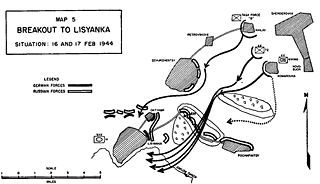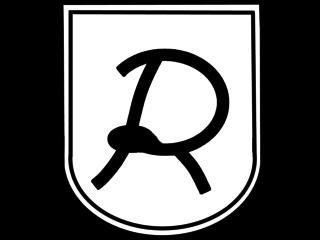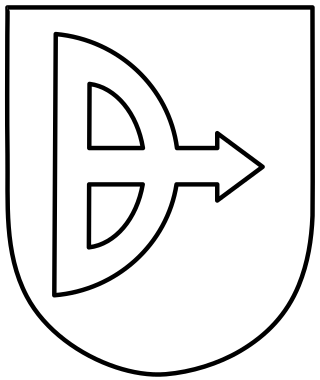History
The 371st Infantry Division, part of the nineteenth wave of infantry divisions formed during the war, was formed at Beverloo Camp in Belgium on 17 February 1942 under the command of the 15th Army. The division nominally fell within the responsibility of Wehrkreis VI (military district VI) and had a home station at Münster.
The division sent to the Eastern Front in June 1942 and was annihilated during the Battle of Stalingrad on 31 January 1943 while subordinated to the 6th Army.
The division was re-established on 17 February 1943 in Brittany from recovered soldiers and replacement troops and reached again full division strength on 9 June 1943. The division was then initially entrusted with coastal protection tasks in Italy and were in December 1943 moved to Croatia to participate in anti-partisan operations. From there it went to northern Ukraine, Poland and Upper Silesia, where it fought in several defensive battles.
At the end of the war, the division surrendered to the Soviets in the Iglau – Deutsch-Brod area in the present-day Czech Republic.
Army Group A was the name of several German army groups during World War II. During the Battle of France, Army Group A was composed of 45½ divisions, including 7 panzer divisions. It was responsible for breaking through the heavily-forested Ardennes region. The operation, which was part of Fall Gelb, was resoundingly successful for the Germans, as the army group outflanked the best troops of France and its allies, eventually leading to France's surrender.

The German 23rd Infantry Division, later the 26th Panzer Division, was a military unit operational during World War II. It was organized along standard lines for a German infantry division. It was non-motorised and relied on horse-drawn wagons for its mobility. The unit carried the nickname Grenadierkopf.

The 13th Panzer Division was a unit of the German Army during World War II, established in 1940.
The 11th Panzer Division was an armoured division in the German Army during World War II, established in 1940.

The 20th Panzer Division was an armoured division in the German Army during World War II. It was created from parts of the 19th Infantry Division.

The German 5th Infantry Division was formed in October 1934 and mobilized on 25 August 1939. The division's troops were garrisoned in Konstanz, Ulm, and Freiburg. When formed, the division consisted of the 1st, 2nd, and 3rd battalions of the 14th, 56th, and 75th Infantry Regiments, the 1st, 2nd, and 3rd Battalions of the 5th Artillery Regiment, the 1st battalion of the 41st Artillery Regiment, and assorted 5th Division support units.
The 21st Infantry Division was a German military unit which fought during World War II.

The 32nd Infantry Division of the German Army was mobilized on 1 August 1939 for the upcoming invasion of Poland. At that time, it consisted of the usual German infantry division elements: three infantry regiments of three battalions each, one three-battalion regiment of light artillery, one battalion of heavy artillery, a Panzerjäger (anti-tank) Battalion, a reconnaissance (Aufklärungs) Battalion, a Signals Battalion, a Pioneer (Engineer) Battalion, and divisional supply, medical, and administrative units.

The 83rd Infantry Division,, was a German reserve and security formation during World War II.

The 14th Panzer Division was an armoured division in the German Army during World War II. It was created in 1940 by the conversion of the 4th Infantry Division.

The 72nd Infantry Division was formed on 19 September 1939 in Trier from Grenz-Division Trier, a border security unit.

The 52nd Infantry Division was an infantry division of the German Heer during World War II, which would become the 52nd Field Training Division in December 1943 and then the 52nd Security Division in April 1944.

117th Jäger Division was a German infantry division of World War II. The division was formed in April 1943 by the reorganization and redesignation of the 717th Infantry Division. The 717th Division had been formed in April 1941. It was transferred to Yugoslavia in May 1941, to conduct anti partisan and Internal security operations.

The 45th Infantry Division was an infantry division of the army of Nazi Germany during World War II. Towards the end of the war, the division was reassembled into a second iteration, the 45th Volksgrenadier Division.

The 15th Infantry Division was an infantry division of the German Army during the interwar period and World War II, active from 1934 to 1945.

The 31st Infantry Division was a German infantry division of the Army during World War II. It participated in the invasion of Poland in 1939 then the invasion of France and the Low Countries in 1940. As part of Panzergruppe 2. of Army Group Centre, it was involved in the invasion of the Soviet Union in June 1941. After hard fighting throughout 1941 and 1942 it joined the 9th Army and fought in the Battle of Kursk in July and August 1943. Along with the rest of the 9th Army, the division conducted a fighting withdrawal for the remainder of 1943, during which it sustained heavy casualties. In the early stages of the Soviet Operation Bagration of June to August 1944, the 31st Infantry Division was destroyed, a fate which subsequently befell most of Army Group Centre. The division was officially disbanded on 18 July 1944.

The 96th Infantry Division was a German division deployed during World War II. It was formed on 25 September 1939 in Bergen as part of the 5th wave (aufstellungswelle).

The 95th Infantry Division was a German division in World War II. It was formed on 19 September 1939 in Wildflecken and Hammelburg.

The 376th Infantry Division was an infantry division of the German Army during World War II, active from 1942 to 1944 in two separate instances.
The 263rd Infantry Division was an infantry division of the German Heer during World War II.
















